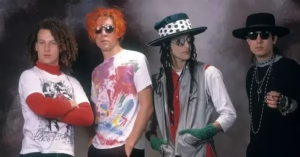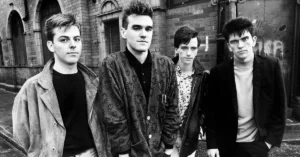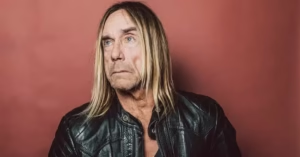The Cure: Masters of Melancholy, Melody, and Modern Romance
The Cure. I. Formation and Early Years
The Cure was formed in Crawley, West Sussex, England, in 1976, initially under the name Easy Cure. The band emerged from the post-punk and new wave movements and was led by:
- Robert Smith – Vocals, guitar, songwriting
- Early members included Lol Tolhurst (drums, later keyboards), Michael Dempsey (bass), and later Simon Gallup (bass) and Porl Thompson (guitar)
Robert Smith became the core and constant member of The Cure, known for his unique voice, mop of black hair, smeared lipstick, pale skin, and lyrical vulnerability.
The Cure. II. The Minimalist Beginning: Three Imaginary Boys (1979)
The band’s debut album was a stark, angular post-punk record that set them apart from the rising punk crowd.
Key tracks:
- “10:15 Saturday Night” – A classic debut single with themes of isolation
- “Grinding Halt”
- “Accuracy”
Though they had not yet found their signature sound, the album introduced Smith’s lyrical introspection and minimalist guitar style.
III. Gloom Trilogy and the Birth of Goth (1980–1982)
With the following albums, The Cure evolved into one of the founding forces of gothic rock, crafting dark, atmospheric, and emotionally raw soundscapes.
✦ Seventeen Seconds (1980)
- Moody and minimalist, featuring the haunting classic “A Forest”
- Sparse instrumentation and icy reverb reflected existential dread
✦ Faith (1981)
- Expanded the gloom into bleak grandeur
- “Primary” and the title track defined their monochromatic sound
✦ Pornography (1982)
- The darkest of the trilogy; despair, chaos, and claustrophobia
- “The Figurehead,” “A Strange Day,” “One Hundred Years”
- Robert Smith: “I had given up on everything, including myself.”
These albums solidified The Cure as pioneers of gothic rock, inspiring bands like Siouxsie and the Banshees, Joy Division, and later Depeche Mode and Nine Inch Nails.
The Cure. IV. Pop Turn and Wider Appeal (1983–1986)
After the suffocating darkness of Pornography, The Cure made a bold shift toward playful, pop-leaning singles while maintaining lyrical depth.
✦ The Top (1984)
- A psychedelic, experimental work where Smith played almost all instruments
- “The Caterpillar,” “Shake Dog Shake”
✦ The Head on the Door (1985)
- A massive breakthrough, balancing goth, pop, and flamenco influences
- “Close to Me,” “In Between Days,” “A Night Like This”
The album broadened their audience and revealed their unique ability to balance light and dark, pop and pathos.
V. Mainstream Success: Kiss Me, Kiss Me, Kiss Me (1987) and Disintegration (1989)
✦ Kiss Me, Kiss Me, Kiss Me
- A sprawling double album showcasing versatility
- From funk (“Hot Hot Hot!!!”) to sorrow (“How Beautiful You Are…”)
- “Just Like Heaven” – Arguably their most beloved song, a perfect blend of pop euphoria and emotional ache
✦ Disintegration (1989)
- Widely considered The Cure’s masterpiece, mixing romanticism, sorrow, and grandeur
- Inspired by Smith’s fear of turning 30
Standout tracks:
- “Pictures of You” – A lush ballad of loss
- “Lullaby” – A gothic fairy tale with sinister undertones
- “Fascination Street” – Hypnotic and danceable
- “Plainsong” – An ethereal, orchestral opener
Disintegration became a commercial and critical triumph, turning The Cure into global superstars while staying artistically pure.
The Cure. VI. 1990s: Sustained Popularity and Reflection
✦ Wish (1992)
- Continued their success with a more guitar-driven, shoegaze feel
- “Friday I’m in Love” – A bright, unapologetic pop anthem
- “High,” “A Letter to Elise” – Introspective yet accessible
✦ Wild Mood Swings (1996)
- Mixed critical reception, noted for its eclecticism
- Tracks like “Strange Attraction” and “The 13th” showed genre diversity
The 1990s saw shifting lineups, personal tension, and inconsistent albums, but Smith’s songwriting still shone through moments of brilliance.
The Cure. VII. 2000s–Present: Resilience and Legacy
✦ Bloodflowers (2000)
- Often seen as the final part of an emotional trilogy with Pornography and Disintegration
- Somber and cohesive, it returned to long-form melancholy and ambient sorrow
✦ The Cure (2004)
- Produced by Ross Robinson (known for Slipknot, Korn)
- A harder, more rock-oriented effort that divided fans
✦ 4:13 Dream (2008)
- A lighter, more polished return
- “The Only One,” “Freakshow,” “Underneath the Stars”
✦ Songs of a Lost World (TBA)
Robert Smith has confirmed a long-awaited new album, promised to be dark and emotionally intense — fans continue to await its release eagerly.
Despite delays, The Cure has remained relevant through touring, headlining major festivals and introducing their music to new generations of alternative fans.
VIII. Musical Style and Themes
The Cure blends:
- Post-punk minimalism
- Gothic rock atmospheres
- Synth-pop brightness
- Dream pop and shoegaze textures
Recurring themes:
- Melancholy, longing, existential dread
- Romance, heartbreak, dreamscapes
- Nighttime imagery, childhood memories, alienation
Robert Smith’s voice is a paradox: fragile and theatrical, intimate and distant, capable of deep sorrow and ecstatic joy.
IX. Legacy and Influence
The Cure is remembered for:
- Shaping gothic and alternative rock
- Blurring the line between underground art and pop accessibility
- Creating a vast, genre-spanning discography loved by emo kids, goths, punks, and romantics alike
Accolades:
- Inducted into the Rock and Roll Hall of Fame (2019)
- Over 30 million albums sold
- Massive influence on bands like:
- The Smashing Pumpkins
- Interpol
- Deftones
- My Chemical Romance
- Mogwai, Muse, and countless indie rock acts
X. Interesting Facts
- Robert Smith played briefly with Siouxsie and the Banshees, influencing his darker songwriting
- “Boys Don’t Cry” became an anthem for emotional vulnerability among men
- Smith is famously media-shy and has remained married to his teenage sweetheart for decades
- Their 1986 compilation Standing on a Beach remains one of the best-selling alternative compilations ever




